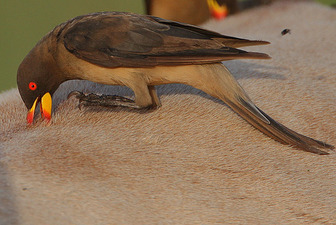Yellow-billed Oxpecker
The Yellow-billed Oxpecker nests in tree holes lined with hair plucked from livestock. It lays 2–3 eggs. Outside the breeding season it is fairly gregarious, forming large, chattery flocks. Non-breeding birds will roost on their host animals at night.

Original source: Yellow-billed Oxpecker (Buphagus africanus)
Author: Steve Garvie from Dunfermline, Fife, Scotland
The Yellow-billed Oxpecker is classified as Least Concern. Does not qualify for a more at risk category. Widespread and abundant taxa are included in this category.
overlaps with Yellow-billed Oxpecker (mostly in East Africa) the Red-billed especially prefers the manes of Giraffe (below) while the Yellow-billed prefers thinner-haired beasts like buffalo or rhino. Oxpeckers use their bills to make quick scissoring movements through the hair but they also spend lots of time working deep in the ears (sometimes only the tail shows) or around the muzzle, eyes or nose. More
Yellow-billed Oxpecker on a wildebeest Oxpeckers feed exclusively on the backs of large mammals. Certain species are seemingly preferred, whereas others, like the Lichtenstein's hartebeest or Topi are generally avoided. Smaller antelope such as lechwe, duikers and reedbuck are also avoided, the smallest regularly used species is the Impala, probably because of the heavy tick load and social nature of that species. In many parts of their range they now feed on cattle, but avoid camels. More
The Yellow-billed Oxpecker, Buphagus africanus, is a passerine bird in the starling and myna family Sturnidae; some ornithologists regard the Oxpeckers to be a separate family, the Buphagidae (Zuccon, 2006). It is native to the savannah of sub-Saharan Africa from Senegal east to Sudan. It is least common in the extreme east of its range where it overlaps with the Red-billed Oxpecker, despite always dominating that species when feeding. More
These Yellow-billed Oxpeckers are picking ticks off an Eland in the Serengeti in Tanzania. The Yellow-billed Oxpecker can be differentiated from the Red-billed Oxpecker by the yellow base to its bill. It lives in a wide band of sub-Saharan Africa.More photos... More
* Yellow-billed Oxpecker, Buphagus africanus of most of sub-Saharan Africa. References - Search Wikimedia Commons Wikimedia Commons has media related to: Buphagidae 1. ^ a b c Zuccon, Dario; Cibois, Anne; Pasquet, Eric & Ericson, Per G.P. (2006). "Nuclear and mitochondrial sequence data reveal the major lineages of starlings, mynas and related taxa". More
The yellow-billed oxpecker (Buphagus africanus) is a small to medium-sized African starling. Also known as tickbirds, oxpeckers have very short legs and sharp claws, which aid them in perching on the backs of large mammals, both wild and domesticated. In addition, yellow-billed oxpeckers exhibit what some would call a symbiotic relationship with these African ungulates. They feed off all ectoparasites that might infect its host. It is native to the savannahs of sub-Saharan Africa , from Senegal east to Sudan. More
Distribution of Yellow-billed oxpecker in southern Africa, based on statistical smoothing of the records from first SA Bird Atlas Project (© Animal Demography unit, University of Cape Town; smoothing by Birgit Erni and Francesca Little). Colours range from dark blue (most common) through to yellow (least common). See here for the latest distribution from the SABAP2. More
For the purposes of our bird news services, Yellow-billed Oxpecker is classed as ungraded: species which are unlikely to appear as wild birds in Britain or Ireland (Note that rarity levels are currently applied nationally and may not reflect local variations in abundance. More
Yellow-billed Oxpeckers have red-tipped yellow bills and lack the bright yellow wattle of its more common congener Status of oxpeckers in South Africa - The status of Red-billed Oxpeckers in South Africa is improving with encouraging expansions from protected areas to farm lands. This species breeds successfully in captivity so re-introduction programs have also been conducted into previously considered marginal areas such as the E Cape. More
Aspects of the topic yellow-billed oxpecker are discussed in the following places at Britannica. Assorted References * description (in oxpecker (bird)) either of the two species of the African genus Buphagus, of the family Sturnidae (order Passeriformes). Both species—the yellow-billed (B. africanus) and the red-billed (B. More
Impala and yellow-billed oxpecker - Gossip is when you hear something you like about someone you don't. previousPrevious Nextnext Artist's notes Impalas are generally grateful for the attention of oxpeckers who relieve them of small unwanted parasites. In this painting, the impala with the oxpecker handily positioned at its ear, could be listening into a bit of Savana gossip. More
captive conditions, Yellow-billed Oxpeckers were constantly dominant over Red-billed Oxpeckers, although there were relatively few direct confrontations. Some mammal species appear to be avoided. Savanna elephants (Loxodonta africana) do not tolerate oxpeckers and quickly chase them off. A few reports from Zimbabwe of oxpeckers on elephants were during a severe drought, when the elephants were in very poor physical condition and appeared totally indifferent to the presence of the birds. More

Original source: Lip Kee Yap
Author: Lip Kee Yap
Permission: Some rights reserved
Family : Sturnidae
Genus : Buphagus
Species : africanus
Authority : Linnaeus, 1766
